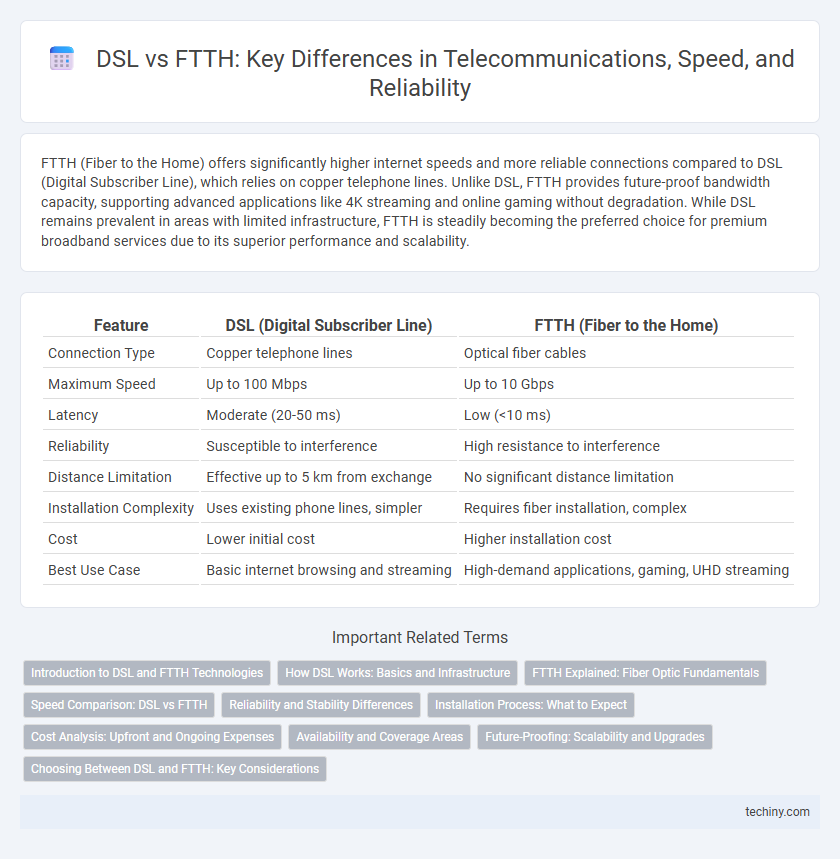FTTH (Fiber to the Home) offers significantly higher internet speeds and more reliable connections compared to DSL (Digital Subscriber Line), which relies on copper telephone lines. Unlike DSL, FTTH provides future-proof bandwidth capacity, supporting advanced applications like 4K streaming and online gaming without degradation. While DSL remains prevalent in areas with limited infrastructure, FTTH is steadily becoming the preferred choice for premium broadband services due to its superior performance and scalability.
Table of Comparison
| Feature | DSL (Digital Subscriber Line) | FTTH (Fiber to the Home) |
|---|---|---|
| Connection Type | Copper telephone lines | Optical fiber cables |
| Maximum Speed | Up to 100 Mbps | Up to 10 Gbps |
| Latency | Moderate (20-50 ms) | Low (<10 ms) |
| Reliability | Susceptible to interference | High resistance to interference |
| Distance Limitation | Effective up to 5 km from exchange | No significant distance limitation |
| Installation Complexity | Uses existing phone lines, simpler | Requires fiber installation, complex |
| Cost | Lower initial cost | Higher installation cost |
| Best Use Case | Basic internet browsing and streaming | High-demand applications, gaming, UHD streaming |
Introduction to DSL and FTTH Technologies
Digital Subscriber Line (DSL) technology delivers high-speed internet over existing copper telephone lines, leveraging frequency division to enable simultaneous voice and data transmission. Fiber to the Home (FTTH) uses optical fiber cables to provide ultra-fast, low-latency broadband directly to residences, supporting greater bandwidth and future scalability compared to copper-based DSL. Both technologies serve as critical infrastructures in telecommunication networks, with FTTH emerging as the superior solution for next-generation internet demands.
How DSL Works: Basics and Infrastructure
DSL (Digital Subscriber Line) transmits high-speed internet over existing copper telephone lines by utilizing higher frequency bands separate from voice signals, enabling simultaneous voice and data communication. The infrastructure involves a DSLAM (Digital Subscriber Line Access Multiplexer) at the telephone exchange that aggregates multiple DSL connections and routes them to the internet backbone. Signal quality and speed depend on the distance between the user's premises and the DSLAM, with speeds decreasing over longer copper line runs.
FTTH Explained: Fiber Optic Fundamentals
FTTH (Fiber to the Home) utilizes fiber optic cables that transmit data as pulses of light, offering significantly higher bandwidth and faster internet speeds compared to DSL, which relies on copper phone lines. Fiber optics' low signal attenuation and immunity to electromagnetic interference enable consistent performance over long distances, making FTTH ideal for high-demand applications like 4K streaming and online gaming. The deployment of single-mode fiber in FTTH networks supports scalable infrastructure upgrades and future-proofs telecommunications services with symmetrical upload and download speeds.
Speed Comparison: DSL vs FTTH
FTTH (Fiber to the Home) delivers significantly higher speeds compared to DSL (Digital Subscriber Line), with FTTH offering symmetrical gigabit speeds up to 1 Gbps or more, while DSL speeds typically max out at 100 Mbps downstream with much lower upload rates. The advanced fiber optic infrastructure in FTTH allows for minimal signal degradation over long distances, ensuring consistent, high-speed internet access. DSL relies on copper telephone lines, which limits bandwidth and results in slower, less stable connections, especially as distance from the provider's central office increases.
Reliability and Stability Differences
FTTH (Fiber to the Home) offers superior reliability and stability compared to DSL (Digital Subscriber Line) due to its use of fiber optic cables, which are less susceptible to electromagnetic interference and signal degradation over distance. DSL relies on copper telephone lines that can experience performance drops during adverse weather and electrical noise, leading to inconsistent connection quality. The inherent physical properties of fiber optics ensure consistent data transmission speeds and lower latency, making FTTH the preferred choice for stable, high-speed internet connections.
Installation Process: What to Expect
DSL installation involves connecting existing copper telephone lines to a modem, typically requiring minimal disruption and a technician visit for wiring and configuration. FTTH installation requires fiber-optic cable deployment directly to the premises, often involving more extensive work such as trenching or aerial cabling, fiber termination, and sophisticated equipment setup. Customers should expect longer installation times and higher complexity with FTTH compared to the generally quicker and simpler DSL setup.
Cost Analysis: Upfront and Ongoing Expenses
DSL connections typically incur lower upfront costs due to existing copper infrastructure but experience higher ongoing expenses from maintenance and limited bandwidth capabilities. FTTH requires significant initial investment in fiber optic installation, driving up upfront expenses, yet offers lower long-term operational costs and superior scalability with reduced need for frequent upgrades. Evaluating total cost of ownership over time reveals FTTH's economic advantage in areas demanding high-speed, reliable internet services despite its higher initial capital expenditure.
Availability and Coverage Areas
DSL leverages existing copper telephone lines, providing widespread availability in rural and suburban areas where fiber infrastructure remains limited. FTTH (Fiber to the Home) offers superior speed and reliability but faces constraints in coverage due to high deployment costs and infrastructure challenges in less densely populated regions. Urban centers have higher FTTH penetration, while DSL continues to dominate in extensive coverage areas lacking fiber networks.
Future-Proofing: Scalability and Upgrades
FTTH (Fiber to the Home) offers superior future-proofing with its unparalleled scalability and higher bandwidth capabilities, supporting multi-gigabit speeds that meet evolving digital demands. DSL technology relies on legacy copper lines, limiting upgrade potential and susceptibility to signal degradation over distance, restricting service quality improvements. As data consumption grows exponentially, FTTH's infrastructure enables seamless upgrades without major overhauls, ensuring long-term network reliability and performance.
Choosing Between DSL and FTTH: Key Considerations
Choosing between DSL and FTTH hinges on factors such as speed, reliability, and availability. FTTH offers superior bandwidth and lower latency, ideal for heavy data use and future-proofing, while DSL remains a cost-effective solution in areas lacking fiber infrastructure. Evaluating service coverage, installation costs, and long-term performance ensures optimal decision-making for both residential and business telecommunications needs.
DSL vs FTTH Infographic

 techiny.com
techiny.com